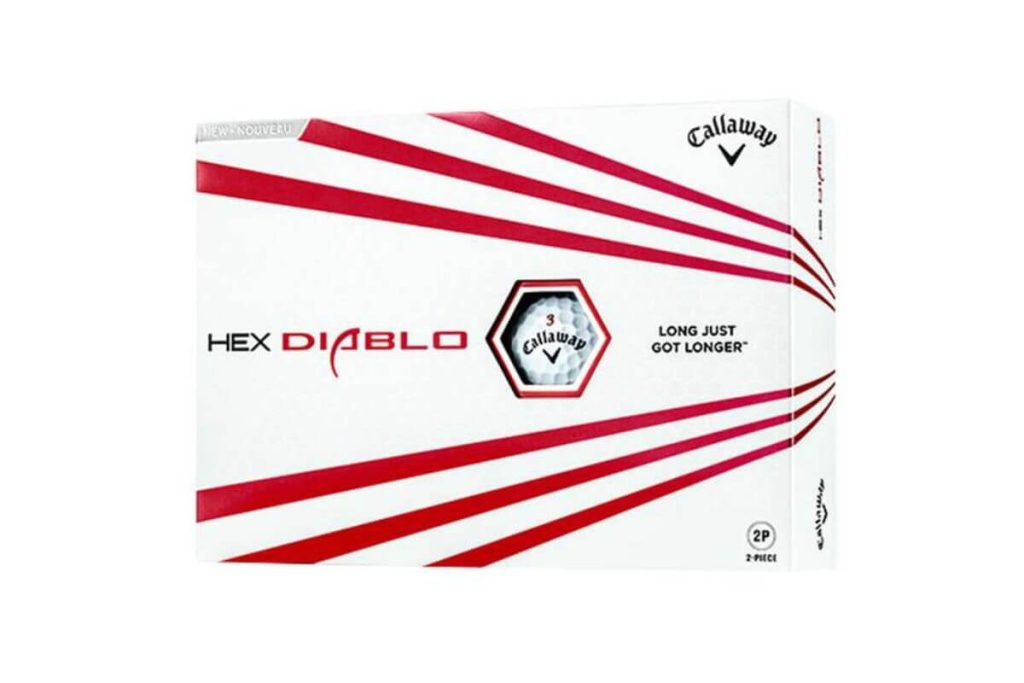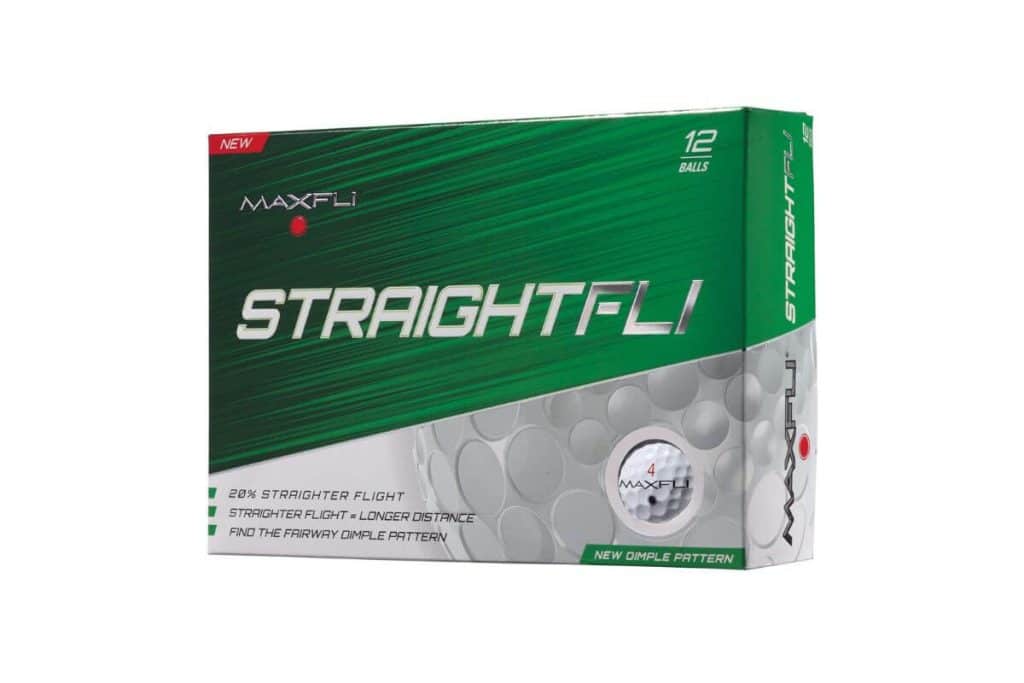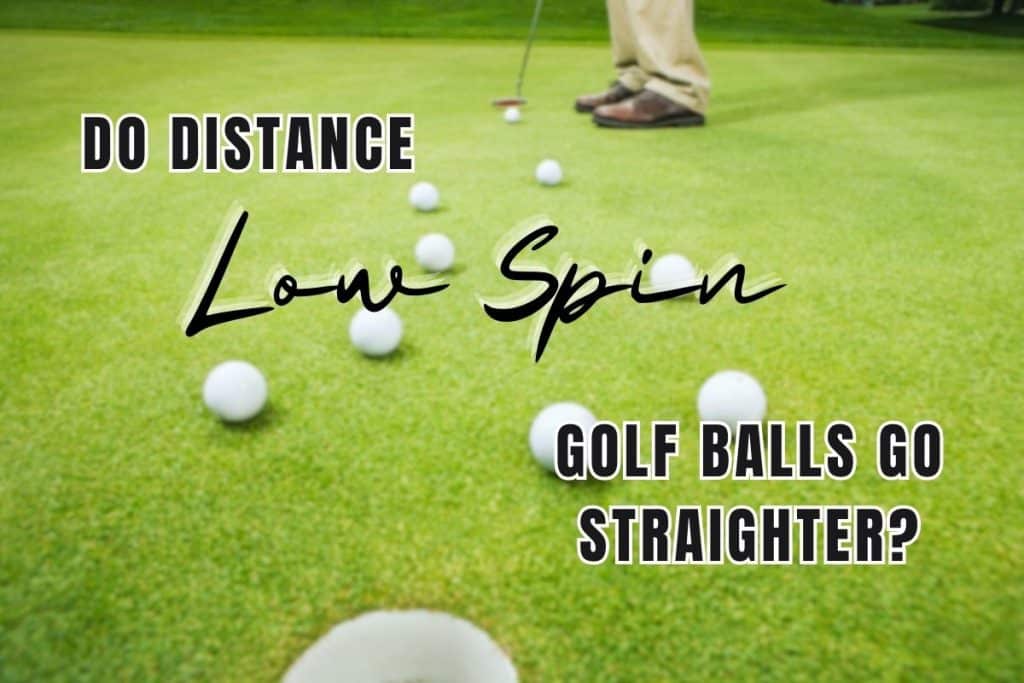If you want a straighter flight, should you be using distance golf balls? It’s a question many amateur golfers want the answer to.
In short, low spin golf balls tend to go straighter and can increase distance for most golfers, especially those struggling with slices or hooks. This is because these balls produce less sidespin and backspin, which can significantly influence the path of a golf ball in flight.
Choosing the right golf ball can make a big difference in getting your shots heading toward the intended target, rather than the rough, and enhancing your overall accuracy on the course.
However, while distance golf balls may help straighten out your flight, this often comes at the expense of control around the greens (as less spin will make the ball harder to stop quickly).
In this article, we’ll explain the pros and cons of distance golf balls to help you decide whether they’re right for you.
Table of contents
Distance vs Premium golf balls: The key differences
Distance balls
Distance golf balls are designed specifically to provide extra length off the tee.
They usually have a firmer construction and a lower compression core, which leads to higher ball speeds and thus, increased distance.
The trade-off is that these balls typically have less spin and feel around the greens, making it more challenging to control shots and stop the ball quickly.
Premium balls
Premium golf balls are designed to provide a more balanced performance across all aspects of the game.
While they might not deliver the same level of distance as specially-made distance golf balls, they make up for it with improved spin and feel around the greens, offering more control on approach shots and on the putting surface.
Most premium balls have a soft urethane cover, which gives them their responsiveness (of course, this comes at a price and attributes to the cost of premium balls normally being higher than distance balls).
So, which ball is better?
The choice between distance golf balls and premium golf balls really comes down to personal preference and your skill level.
If maximizing distance is your primary goal and you’re not as concerned about short game control, then distance balls might be the right choice for you.
However, if you value consistent performance in all areas of the game, including spin and feel around the greens, you may be better off with a premium golf ball.
Personally, I started off using distance golf balls when I was a high handicapper, but as my scores began to come down, I opted to switch to premium balls as I found I needed more control with my short game.
If you’re just starting out in golf, I’d recommend saving a few dollars by using distance balls until you find some consistency in your swing.
Why do distance golf balls fly straighter?
Distance golf balls generally fly straighter because they spin less when struck by the golf club. Distance balls often have harder exteriors, making it harder to impart spin. As a result, the ball will deviate less during flight.
Golf ball dynamics play a critical role in the way our shots travel through the air.
The main elements we need to consider are spin, sidespin, backspin, dimple pattern, and the number of dimples on the ball.
When hitting a golf ball, spin is generated. The spin rate of a golf ball can significantly affect the shot’s distance and trajectory.
Types of spin
There are typically two types of spin that we encounter in golf: backspin and sidespin. Backspin helps the golf ball climb upwards, while sidespin can cause the ball to curve left or right.
Generally, low spin golf balls (such as distance balls) will travel straighter and slightly farther for most golfers compared to high-spinning balls, as they generate less sidespin and backspin.
Dimple patterns and the number of dimples on a golf ball contribute to its flight characteristics as well. The dimples reduce air resistance, allowing the ball to fly longer distances.
Golf balls have anywhere from 300 to 500 dimples, and the pattern can vary between manufacturers. Dimples help create lift, which works along with backspin to enable the ball to maintain its flight path.
The combination of spin, dimple pattern, and dimple count can significantly impact a golf ball’s trajectory and distance.
Golf ball technologies that aid straighter flights
Over the years, there have been several key golf ball technologies developed to provide straighter ball flights. I’ve mentioned some of the main ones below.
Alignment aids
One of the most straightforward enhancements in golf ball technology is the alignment aid.
These are basic markings on the golf ball that help guide you in lining up your shot – essentially acting as a visual aid for positioning the ball’s path.
Simply align the marking on the ball with your intended target, and this can help increase your accuracy and lead to a straighter flight.
Hex aerodynamics
Another technology that has significantly improved the aerodynamics of golf balls is hex aerodynamics.

This refers to hexagonal-shaped dimples found on some golf ball designs, for example, those from Callaway.
Hex aerodynamics helps to reduce drag and increase lift, which translates to straighter and longer ball flights.
Contact force dimples
Contact force dimples, coined by Bridgestone and used in balls such as the Bridgestone e12 ball, can also play a crucial role in achieving a straighter flight.
These specially designed dimples, which have a chainlink-style appearance, promote optimal lift by managing airflow around the ball.
The larger contact area this creates allows more energy to pass through the ball, producing more speed and therefore distance.
Self-correcting mechanisms
The advent of self-correcting golf balls isn’t really relevant for serious golfers, as they’re illegal to use during competition and are more of a gimmick product.
Essentially, these balls have an asymmetrical dimple design, like the Polara Ultimate Straight Self-Correcting Golf Balls, which helps minimize sidespin and ultimately leads to a straighter flight.
They’re fun to use as a bit of a laugh, but not if you’re playing a proper round.
Most popular straight distance golf balls
If you’re looking to maximize your distance, the below list of golf balls are a great place to start.
These balls are designed for low spin and will definitely add some extra length to your game (an added bonus is they’re very budget-friendly, too).
Maxfli StraightFli
The Maxfli StraightFli is designed to reduce sidespin, which helps in promoting a straighter ball flight. I’ve found that these balls perform well for golfers who struggle with slicing or hooking their shots. The dimple pattern reduces drag and contributes to a longer carry as well.

Titleist Velocity
The Titleist Velocity golf ball is a good option for golfers looking for both distance and accuracy. Its high energy core provides explosive distance off the tee, while its low spin characteristics assist in achieving straighter shots.
Bridgestone e12 Contact
The Bridgestone e12 Contact ball has a unique dimple design that helps it maintain a straighter flight path and provides increased distance. I found it to be a good option for those looking for added accuracy without sacrificing yards on their shots.
Callaway Supersoft
Another great option is the Callaway Supersoft, which has a soft feel and low spin characteristics. In my experience, this ball provides a satisfying blend of distance and straight flight, making it suitable for golfers who want a more forgiving ball with a soft feel around the greens.
Srixon Soft Feel
The Srixon Soft Feel is designed for low spin and a soft feel. These balls are not only forgiving on off-center shots but also offer decent distance. I’ve found that they can help beginners develop a consistent and straighter ball flight.
Wilson Ultra 500 Straight Golf Ball
The Wilson Ultra 500 focuses on reducing hooks and slices with its high-energy core. In my experience, this ball offers a consistent straight flight and decent distance, making it an excellent option for beginner golfers.
In summary, the golf balls mentioned above each offer unique features designed to help golfers achieve straighter and longer shots.
Experimenting with different brands and models may assist in finding the best option for your specific needs and preferences.
How swing speed and control impacts ball flight
In golf, swing speed plays a big role in determining the distance a ball travels. The faster the swing, the more energy is transferred to the ball, resulting in greater distances. However, faster swings don’t necessarily mean straighter shots – control is just as (if not more) essential for accuracy and consistency in ball flight.
When it comes to controlling the ball, the clubface and swing path are key factors.
Clubface control
The direction the clubface is pointing at impact and the direction the clubhead is moving at impact both have a significant effect on ball flight.
For instance, if the clubface is open during impact, the ball will most likely start on the right side of the target, whereas a closed clubface will cause the ball to start on the left side of the target.
This will also influence how the ball moves through the air and either add or subtract distance (fade shots tend to fly shorter and land softer, while draw shots usually fly longer and roll further).
Swing path
Swing path also affects the golf ball’s trajectory and distance.
A right-handed golfer who swings from an inside-out path will likely create a counterclockwise spin on the ball, which will make the ball move right to left in the air (draw, for a right-handed player).
On the other hand, a swing path that is outside-in will create a clockwise spin, making the ball move left to right during flight (fade, for a right-handed player).
So, while faster swing speeds can result in longer shots, you mustn’t neglect the elements of control (such as proper clubface alignment and an optimal swing path) needed to keep the ball on your desired flight path.
By working on these aspects of your swing, you’ll be well on your way to hitting straighter, longer and more accurate shots on the course.
How golf ball feel and compression impacts distance
Golf ball feel and compression are two more factors that affect the distance of your shots. The better you compress the golf ball, the more energy you will exert on it and the longer it will fly.
Different golf balls produce different feels, which can range from soft and cushioned to hard and firm. The feel of a golf ball is primarily determined by its compression, which is a measure of how much the ball deforms when struck.
Golf balls come in various compression ratings, typically ranging from 50 to 100, although some balls have ratings as low as 38, like the Callaway’s Supersoft golf ball.
Generally speaking, a higher compression rating indicates a firmer feel, while a lower rating indicates a softer feel.
A ball with a lower compression rating and a softer feel is generally easier to compress, making it more forgiving as it will tend to have less sidespin and often result in straighter shots.
By comparison, golf balls with higher compression ratings and a firmer feel provide more control and are better suited for more advanced players.
These balls require a more powerful swing to compress, which can lead to increased distance, more backspin, and better stopping power on the greens.
However, they can also magnify any flaws in your swing, making it more challenging to achieve a straight shot.
Frequently Asked Questions (FAQs)
Do certain golf balls improve accuracy?
Yes, some golf balls are designed to enhance accuracy, especially for amateur golfers. In general, low spin golf balls tend to go straighter and, as a result, help improve accuracy for most golfers compared to high-spinning balls.
These balls help minimize the effects of side spin, which can cause hooks or slices.
Are soft golf balls better for controlling ball flight?
Soft golf balls provide better feel and control around the greens, making them easier to work with for short game shots. However, when it comes to controlling ball flight in your long game, it depends on your swing and preferences.
I personally prefer softer balls because they give me more control over my iron shots, but it might be different for you.
What are the best low spin golf balls for straight shots?
There are several options when it comes to low spin golf balls that help with straight shots. Some popular choices include Titleist’s Velocity, Callaway’s Supersoft, and Bridgestone’s e12 series.
I’ve had good experiences with these balls, but it’s always a good idea to test different options to find what works best for you.
What factors contribute to a straighter golf ball flight?
Several factors contribute to a straighter golf ball flight. First, the golf ball’s design itself plays a role, as low spin balls are designed to minimize side spin that causes hooks and slices.
Second, center contact with the clubface is crucial, as solid ball-striking increases ball speed and leads to straighter shots.
Lastly, swing technique plays a key role. Maintaining a proper swing plane, balance, and follow-through can help promote a more accurate ball flight.


